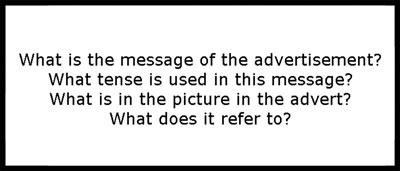2 Using advertisements
You have probably noticed that English is often used for advertisements, either on its own or together with other Indian languages (see Figure 1). Advertisers may use English because they think it makes a product look more modern, international or marketable. Using English – and mixing it with other languages – can also make an advertisement seem more interesting, creative or humorous.
Advertisements using English can be used in the classroom as a prompt for English speaking and writing activities. You can discuss the language used in the advertisement, how it is used, why it is used, and so on. By analysing the language used in advertisements you can also help to develop the students’ critical thinking skills.
Note in Case Study 1 how Mr Chourdhury chooses an advert that the students are familiar with and find interesting, which results in them being motivated to express their ideas. This allows Mr Choudhury to find out about their ideas and helps to improve their communication skills.
Case Study 1: Mr Choudhury uses an advertisement in English in a classroom activity
Mr Choudhury teaches English to Class IX. Here, he tries an activity with an advertisement in English to raise his students’ awareness of the use of English in their local area.
I recently saw a new advertisement for Amul butter [Figure 2] and realised that it was mostly in English. I know that my students are familiar with such adverts, and I thought they would probably enjoy talking about them in class. So I began to think about how I could use an advert like this in my teaching.
 Figure 2 Amul butter advertisement.
Figure 2 Amul butter advertisement.
I cut the advertisement out and stuck it on a piece of chart paper. I then prepared a few questions about the advert. I decided that instead of going straight to a textbook activity, we would spend the first 15 minutes of class talking about at the advert. That would still give us enough time to do textbook work in the lesson.
At the beginning of the class, I passed the advertisement around the students, making sure that each one had a chance to look at it. Many of them seemed to recognise it. While the students were looking at the advert, I wrote the following questions on the board:
I asked the students to discuss these questions in pairs. Then I called on individual students to answer the questions. Some noticed that the main message of the advert (‘Speak less, eat more!’) was in the imperative. Most knew that the advert referred to the Bollywood film Barfi, in which a very lovable deaf and dumb boy (which explains ‘speak less, eat more’) named Barfi ferries the heroine around town on his bicycle and has many delightful mishaps.
I then asked the students:
At first, the students didn’t have many ideas about why English was used. So I asked them if they thought that using English made people want to buy things more. Some of the students thought that it might. Then one student said that maybe they use English because butter is a product that English people use more than Indian people. I thought that was an interesting idea.
They thought it was a good advertisement because they liked the picture. They thought that the slogans were creative because they made creative use of both English and Hindi. They also made references to current events in film, sports and politics.
We did most of this discussion in Hindi because I wanted them to feel free to express their ideas about the advertisement. But the next time that I do an activity like this, I will ask the students to use more English. They really enjoyed talking about the advertisement, and they were much more lively and talkative than they usually are.
Activity 2: Try in the classroom – using an advertisement
Follow this guidance to try using a local advertisement in your class:
- Before class, find a local advertisement that uses English. It could be from a newspaper or magazine, or even a photo of one taken with your mobile phone. If you have access to the internet you could download and print an advertisement like theAmul advert.
- Decide what the purpose of the activity is. Are you teaching particular vocabulary or grammar? Or is the primary purpose for you students to speak in English?
- Decide how long you want the activity to be. You may just want to use the advertisement to prompt a brief discussion at the beginning or end of a class.
- Prepare the questions that you will ask students about the advertisement. These will relate to the purpose of the activity.
- In class, show the advertisement so that all students can see it.
- Write your questions on the blackboard. These are some examples but you will have your own questions depending on the level of your class, the purpose of the activity and the particular advertisement you are using:
- What is the message of the advertisement?
- Can you guess the meaning of all the English words?
- What tense is used in the message?
- Is there any word play in the message?
- Describe what is in the picture in the advert. Why do you think that picture was chosen?
- Use English to ask questions, and encourage your students to reply in English by giving them some of the vocabulary and grammar that they will need to answer the questions.
- Finish the activity by discussing whether or not the advertisement is effective, and what makes it effective. For example, you could ask:
- Why do you think that English is used in the advertisement?
- Do you think that this is an effective advertisement? What makes a good advertisement?
This discussion might be done in students’ home language, as the main focus is to get them thinking critically about the use of language in advertising. If, however, you would like to challenge your students to hold this discussion in English, there are some ideas to help you plan this in the unit Supporting speaking in English: pair and group work.
Pause for thought Here are some questions for you to think about after trying this activity. If possible, discuss these questions with a colleague.
|
There are plenty of examples of advertisements that you could use in your classroom. Look for examples that you think would be interesting and familiar for students and would motivate them to talk and write. Advertisements that are funny and make use of multiple languages or word play can be particularly useful. When choosing an advertisement, you should try to connect it to the curriculum and textbook lessons that you are teaching. For example, you could focus on the use of tense, how the passive voice is used, or how prepositions or adverbs are used in the advert.
You could also ask students to find advertisements themselves. This will be motivating for students and will help you to find out about their interests and the English words or phrases that they are familiar with. You could ask students to design their own advertisement using English – see Resource 1 for some ideas about a project on creating advertisements.
1 English in your local area


